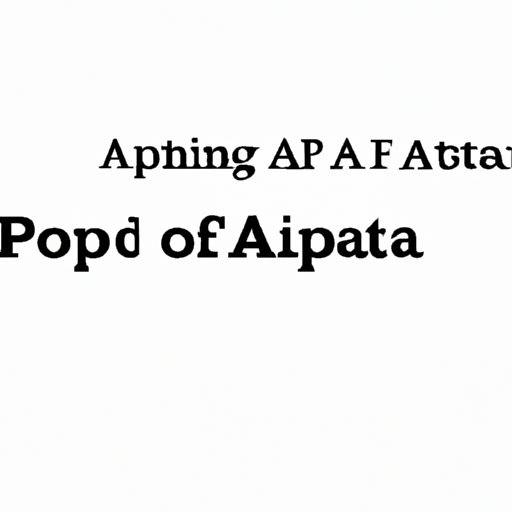
I. Introduction
Writing in APA format is essential in the academic world. APA stands for the American Psychological Association, which created a set of guidelines for writing and formatting academic papers and research studies. Proper formatting ensures that papers are consistent and understandable, making them easier to read and evaluate.
In this article, we will be exploring a beginner’s guide to writing in APA format, 10 tips for mastering the writing style, how to avoid common APA formatting mistakes, advanced APA writing techniques, and formatting for specific writing styles. By the end of this article, readers will have a comprehensive understanding of APA format and how to write in this style.
II. A Beginner’s Guide to Writing in APA Format
The basics of APA format include the title page, running head, abstract, body, in-text citations, and reference page. The title page should include the title of the paper, author’s name, and institutional affiliation. The running head is a shortened version of the title, no longer than 50 characters, that appears at the top of every page. The abstract is a brief summary of the paper’s main points and is typically between 150-250 words. The body should include an introduction, methods, results, discussion, and conclusion.
In-text citations are crucial in APA format because they acknowledge the sources used in the paper and allow readers to locate them in the reference page. They should include the author’s last name and publication year. Direct quotations should include the page number as well. The reference page comes at the end of the paper and should include all sources referenced in the paper, in alphabetical order.
III. 10 Tips for Mastering APA Writing Style
1. Use proper heading formatting: APA format includes standard heading levels, ranging from level 1 to 5. These should be consistently formatted throughout the paper.
2. Use appropriate abbreviations: Use only commonly accepted abbreviations in APA format.
3. Use visual aids to enhance the paper: Tables, figures, and graphs can help visualize data and information.
4. Use proper sentence structure: Sentences should be clear and concise, with proper grammar usage.
5. Use precise language: Avoid using vague language or generalizations in APA writing.
6. Use proper capitalization: APA format requires specific rules for capitalizing titles and headings.
7. Use active voice: Active voice makes writing more concise and engaging.
8. Use proper citation formatting: APA citation formatting includes rules for citing different types of sources, including books, journals, and websites.
9. Use proper punctuation: APA format requires appropriate use of commas, periods, and other punctuation marks.
10. Use appropriate tone: APA writing should be formal and objective.
IV. How to Avoid Common APA Formatting Mistakes
Some common mistakes in APA writing include improper citation formatting, incorrect heading formatting, and not following guidelines for in-text citations. To avoid these mistakes, be sure to consistently review guidelines, use an APA citation guide, and double-check formatting before submitting a paper.
V. APA Writing Made Easy
To make APA writing easier, create an outline, use templates for formatting, and review examples of papers written in APA format. Outlines can help structure thoughts and ideas, while templates provide a framework for formatting and saving time. Examples of papers written in APA format can provide guidance on formatting, citation rules, and writing style.
VI. APA Formatting for Specific Writing Styles
Different writing styles, such as research studies and literature reviews, may have specific formatting requirements in APA format. For example, research studies typically have specific sections, such as methods and results. Literature reviews may require more detailed references for sources. It’s important to review specific formatting requirements for each type of writing style.
VII. Advanced APA Writing Techniques
Advanced techniques for improving APA writing include writing effective abstracts, properly using appendixes, and correctly formatting references for online sources. An abstract should summarize the key points of the paper and be written in a concise and direct manner. Appendixes should be used to provide supplementary information that may not fit in the main body of the paper. References for online sources should include a DOI or URL, date accessed, and other relevant information.
VIII. Conclusion
Writing in APA format is crucial in the academic world, and following proper guidelines helps ensure consistency and credibility. By using the tips and techniques provided in this article, readers can improve their writing and achieve success in their academic endeavors. Remember to consistently review guidelines, use templates for formatting, and double-check formatting to avoid common mistakes. Writing in APA format can be made easier with practice and familiarity, and the results will be well worth the effort.





